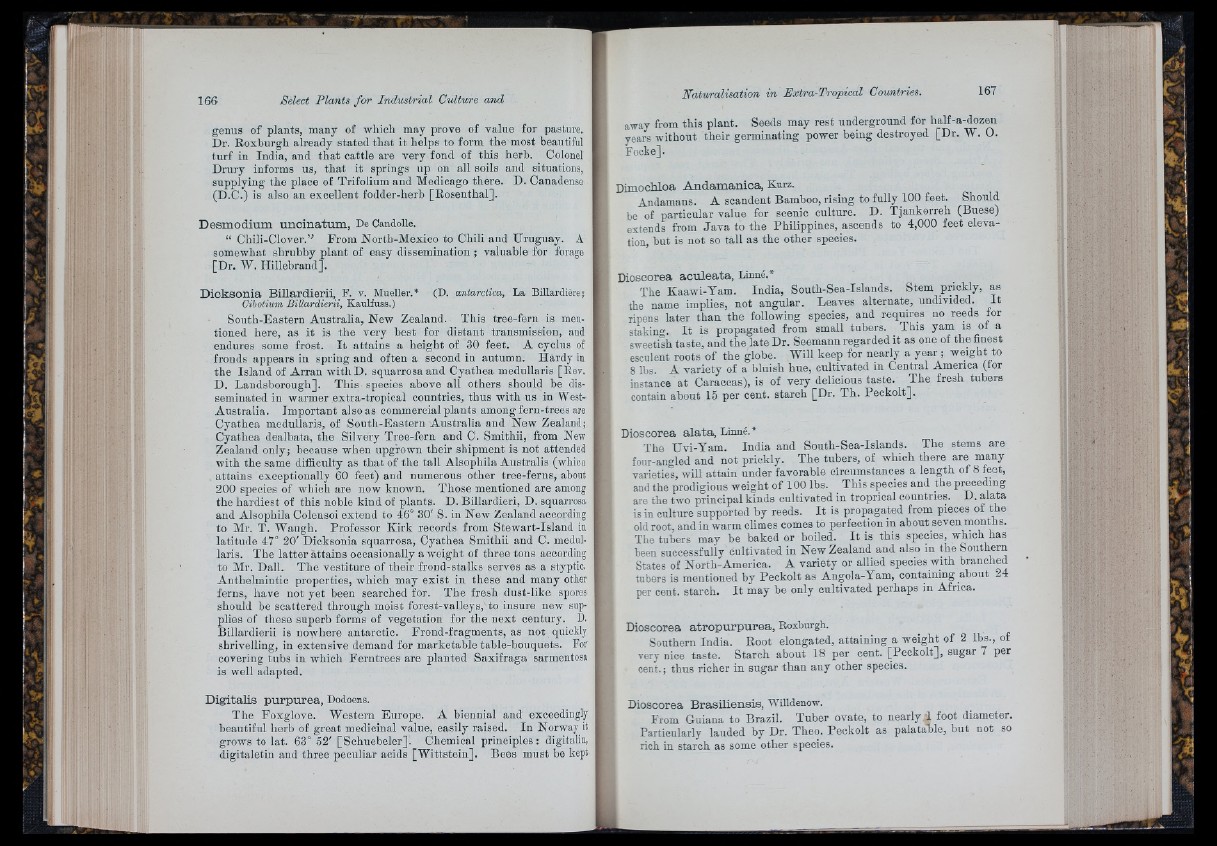
166 Select Plants fo r Industrial Culture and
genus of plants, many of which may prove of value for pasture.
Dr. Roxburgh already stated th a t it helps to form the most beautiful
tu rf in India, and that cattle are very fond of tliis herb. Colonel
Drury informs us, that it springs up on all soils and situations,
supplying the place of Trifolium and Medicago there. D. Canadense
(D.C.) is also an excellent fodder-herb [Rosenthal].
D e sm o d ium u n o in a tum , De Candolle.
“ Chili-Clover.” From iSiorth-Mexico to Chili and Uruguay. A
somewhat shrubby plant of easy dissemination ; valuable for forage
[Dr. W. Hillebrand;.
D io k so n ia BiUardierii, F. v. Mueller.*
Cihotium Billardierii, Kaulfuss.)
(D. antárctica, La Biliardière;
South-Eastern Australia, New Zealand. This tree-fern is mentioned
here, as it is the very best for distant transmission, and
endures some frost. I t attains a height of 30 feet. A cyclus of
fronds appears in spring and often a second in autumn. Hardy iu
the Island of Arrau w ithD . squarrosa and Cyathea medullaris [Rev.
D. Landsborough]. This species above all others should he disseminated
in warmer extra-tropical countries, thus with us in West-
Australia. Important also as oommeroial plants among fern-trees are
Cyathea medullaris, of South-Eastern Australia and New Zealand;
Cyathea dealbata, the Silvery Tree-fern and C. Smithii, from New
Zealand only; because when upgrown their shipment is not attended
with the same difficulty as that of the tall Alsophila Australis (wliicn
attains exceptionally 60 feet) and numerous other tree-ferns, about
200 species of which are now known. Those mentioned are among
the hardiest of this noble kind of plants. D. Biliardieri, D. squarrosa
and Alsophila Colensoi extend to 46° 30' S. in New Zealand according
to Mr. 'T. Waugh. Professor Kirk records from Stewart-Island in
latitude 47° 20' Dicksonia squarrosa, Cyathea Smithii and C. medullaris.
The latter attains occasionally a weight of three tons according
to Mr. Dali. The vestiture of their frond-stalks serves as a styptic.
Anthelmintic properties, which may exist in these aud many other
ferns, have not yet been searched for. The fresh dust-like spores
should be scattered through moist forest-valleys, to insure new supplies
of these superb forms of vegetation for the next century. D.
Billardierii is nowhere antarctic. Frond-fragments, as not quickly
shrivelling, in extensive demand for marketable table-bouquets. For
covering tubs in which Ferntrees are planted Saxifraga sarmentosa
is well adapted.
D ig ita lis p u rp u r e a , Dodoens.
The Foxglove. Western Europe. A biennial and exceedingly
beautiful herb of great medicinal value, easily raised. In Norway it
grows to lat. 63° 52' [Schuebeler]. Chemical principles: digitalin,
digitaletin and three peculiar acids [Wittstein], Bees must be kept
away from this plant. Seeds may rest underground for half-a-dozen
years without their germinating power being destroyed [Dr. W. O.
Focke].
Dimoohloa A n d am a n ic a , Kurz.
Andamans. A scandent Bamboo, rising to fully 100 feet. Should
be of particular value for scenic culture. D. 'Tjankorreh (Buese)
extends from J a v a to the Philippines, ascends to 4,000 feet elevation,
but is not so tall as the other species.
Dioscorea a c u le a ta , Linné.*
The Kaawi-Yam. India, South-Sea-Islands. Stem prickly, as
the name implies, not angular. Leaves alternate, undivided. I t
ripens later than the following species, and requires no reeds for
s t a k i n u . I t is propagated from small tubers. This yam is of a
vweetish taste, and the late D r. Seemann regarded it as one of the finest
esculent roots of the globe. Will keep for nearly a y e a r; weight to
8 lbs. A variety of a bluish hue, cultivated in Central America (tor
instance a t Caraccas), is of very delicious taste. The fresh tubers
contain about 15 per cent, starch [Dr. Th. Peckolt].
Dioscorea a la ta , Linné.*
The Uvi-Yam. India and South-Sea-Islands. The stems are
four-angled and not prickly. The tubers, of which there are many
varieties, will attain under favorable circumstances a length of 8 feot,
and the prodigious weight of 100 lbs. This species and the preceding
are the two principal kinds cultivated in troprical countries. D. alata
is in culture supported by reeds. I t is propagated from pieces of the
old root, and in warm climes comes to perfection in about seven months.
The tubers may be baked or boiled. I t is this species, which has
been successfully cultivated in New Zealand and also in the Southern
States of North-America. A variety or allied species w ith branched
tubers is mentioned by Peckolt as Angola-Yam, containing about 24
per cent, starch. I t may be only cultivated perhaps m Africa.
Dioscorea a tr o p u rp ú r e a , Roxburgh.
Southern India. Root elongated, attaining a weight of 2 lbs., of
very nice taste. Starch about 18 per cent. [Peckolt], sugar 7 per
cent.; thus richer in sugar than any other species.
Dioscorea B ra silie n sis , Willdenow.
From Guiana to Brazil. Tuber ovate, to nearly 1 foot diameter.
Particularly lauded by Dr. Theo. Peckolt as palatable, but not so
rich in starch as some other species. I